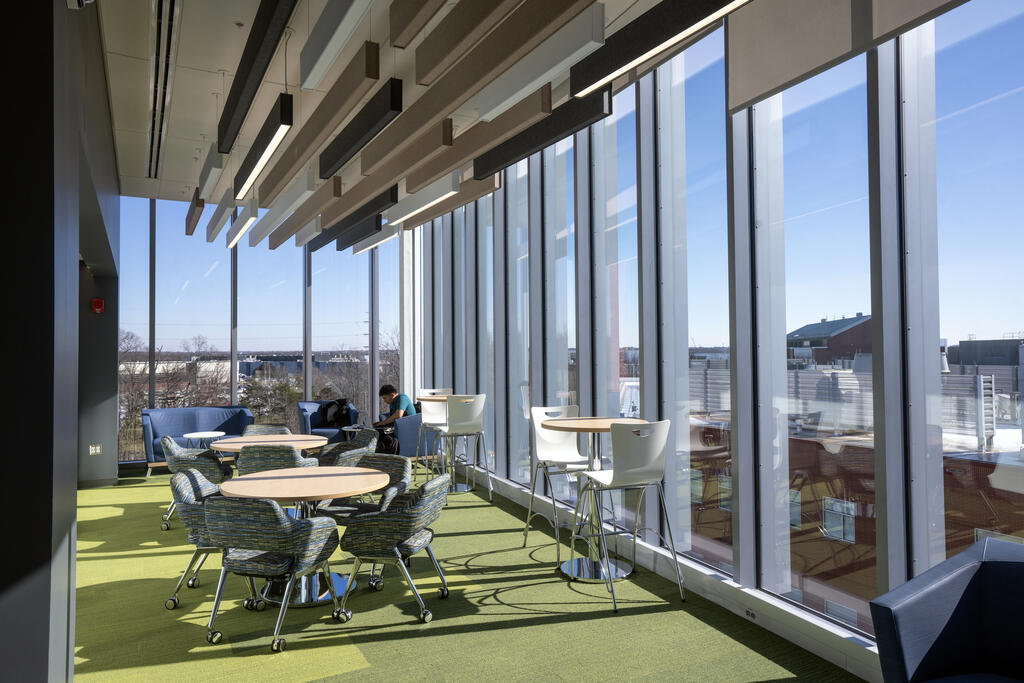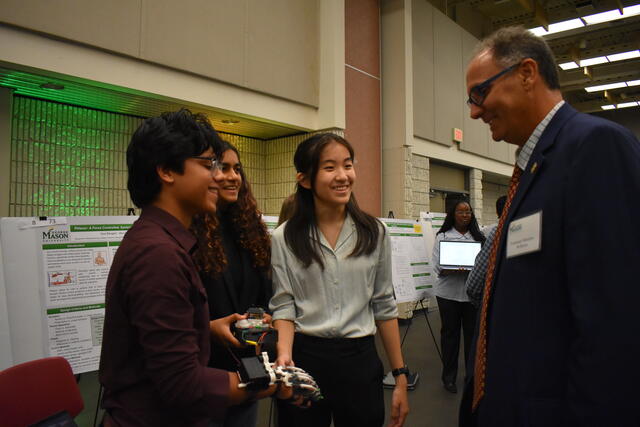Admission CTAs
Dean’s blog: Aspiring scientists immersed in meaningful STEM research at Mason
Impactful science research and outreach opportunities can change one’s professional trajectory. When and how often you experience them can be key to the rapid rise. Within the science realm at Mason, we drive that impact on a daily basis. And one stellar example of this is our Aspiring Scientist Summer Internship Program (ASSIP). For more than a decade, we have created inspiring, immersive science-based research and innovation opportunities for high school and early undergraduate students.
Last week, we heard from the participants, assembled their mentors and parents and literally saw the future impact of meaningful STEM research. I can honestly say, experiencing the online and face-to-face poster session was the most exciting 24 hours I’ve had thus far in 2023. As I reviewed the displays of work that these young minds have done over the past eight to ten weeks, I am just so impressed and happy.
The future looks very bright for STEM.
The 2023 Mason ASSIP program supported an unprecedented 272 total participants with more than 70 mentors. The visionary Mason ASSIP experience began as a small group of students across the physical sciences within our College of Science. Now this in-demand program has an expanded impact, involving mentors across other Mason disciplines and campuses, the College of Engineering and Computing, College of Visual and Performing Arts, Schools of Public Health and Business, and drawing participants from northern VA, across the DMV, other states, and also students from other countries. It was great to see the research collaborations from students from my native Venezuela, and even from South Korea, near Mason’s expanding Incheon Global campus in Songdo.
And this is very heartwarming for me.
To the parents of these participating students, this enterprise is so much better because of your support of your children doing this. I can say, the possibility of a bright future in STEM can happen over time. Neither of my two daughters, at first wanted to pursue a career in the sciences, however, over time, both have shifted their career focus (one to teach science and become a scientific researcher), further illustrating the evolving and expanding STEM workforce allure.
My kids will say, “You are such a boomer, dad.” As we all age, we start contemplating how our generation does things versus how the new generation does things. And we have differences. And yes, there should be differences. The only difference for me is I don’t complain about how the new generation are doing things. I actually admire how they are doing things, because the world will be so much better when this incoming generation is in charge. What a comforting thought.
Why study STEM? Because success in the STEM workforce is lucrative and growing. At 2%, prior to the pandemic, unemployment was lower among the STEM workforce than the 4% rate non-STEM-based labor pool. And now in a post-COVID pandemic world, areas like medicine and health, space, the environment and climate, and quantum and materials sciences just to name a few will change the types of opportunities for the next generation. And the world’s demand for workers in STEM fields will continue to rapidly expand. According to the National Science Foundation, (NSF), from 2011 to 2021, the STEM workforce grew by 5.9 million to 34.9 million (a 20% increase) and the percentage of STEM workers in the total workforce rose 3% to 24%.
Gone are the days when parents just wanted their children to pursue degrees as a lawyer or doctor because they knew the impact and economic compensation was substantial (don’t get me wrong, they still are). Now high schoolers also aspire to be scientists, engineers, or even more specifically physicists, epidemiologists, forensics and data scientists as well. And through activities like ASSIP, today’s parents can explore the next wave of opportunities.
I’ve met with parents now encouraging their children to cultivate their intellect and impact in such fields as neuroscience, biochemistry, environmental science and policy, mathematical modeling and data science, and space exploration. Career opportunities are evolving so our science curriculums and outreach activities have to evolve with them to prepare the future workforce to not just fill the huge need, but also to drive the change and innovation our society will need to thrive.
I connected with many ASSIP students and participating mentors. One of the interns was trying to convince her parents to stay paired with her Mason mentor for at least another month, or maybe the full next year to do research. There is no better testament to the experiences and research being done here than that.
A special thanks and a key component of this ASSIP enterprise is the mentors. With 72 mentors, as we do the math, we see there were mentors working with more than one student, which is so fantastic as that is a ton of work. I know our faculty mentors truly enjoy doing it which was never more evident than at the 120 in person and 90 virtual poster presentations. Not only are they establishing a great legacy, they are open to the creative ideas of this next generation of aspiring scientists who bring creative insightful ways forward to solve grand and difficult problems.
I heard poster presentations across all areas of scientific knowledge-- cancer, epidemiology, gentrification, public opinion, tuberculosis, neurofibromatosis and meningiomas. HIV, climate change, Alzheimer’s, law enforcement, racism, and quantum computing-- the list was long. The future is bright because we have these researchers and their work to look forward to in time.
I so appreciate these aspiring scientists, mentors, and their families for being at Mason, and taking the time to do this, (even those parents who drove 90 minutes each way to make sure their students could fully participate in this life changing research opportunity at their onsite laboratories). These efforts will certainly fuel participants’ stem success.
Mason prides itself on providing access to transformative, impactful learning experiences. ASSIP participants have forged relationships with mentors, not just working with their paired scientists for the summer, but really potentially life-long relationships. Many of the ASSIP scientists will become part of the growing and influential Mason network of relationships. As they go through life, building that network of scientific peers and collaborators to bounce off ideas will become invaluable. It starts right here, right now, with this ASSIP group.
A huge thank you to the ASSIP organizing team, Amanda Haymond, Marissa Howard, Lance Liotta and Natasha Boddie. The fun and learning don’t have to stop at this program. We have hundreds of STEM success stories from ASSIP participants growing their science and research skills here at Mason and around the world. Tell your friends, aspiring scientists and mentors, to come join us in this effort.

